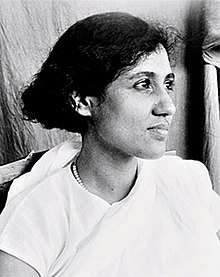Rashid Jahan
Rashid Jahan (25 August 1905 – 2 July 1952) was an Indian writer who inaugurated a new era of Urdu literature written by women. She wrote short-stories and plays and is perhaps best remembered for her involvement with the explosive Angaaray (1932), a collection of groundbreaking and unconventional short stories written by young writers in Urdu like Sajjad Zaheer and Ahmed Ali.[1]
Rashid Jahan | |
|---|---|
 | |
| Born | 25 August 1905 Aligarh, Uttar Pradesh, India |
| Died | July 2, 1952 (aged 46) Moscow, Russia |
| Resting place | Moscow, Russia |
| Occupation | Writer |
| Language | Urdu |
| Alma mater | Aligarh Muslim University, Isabella Thoburn College, Lady Hardinge Medical College |
| Genre | Short stories |
| Literary movement | Progressive Writers Movement |
| Notable works | Angaaray (1932) |
| Spouse | Mahmuduz Zafar |
| Relatives | Begum Khurshid Mirza (sister) |
Early life
She was born on 25 August 1905 in Aligarh. She was the eldest of five children born to Sheikh Abdullah (educationalist) and his wife Begum Wahid Jahan. Her father, Sheikh Abdullah (not to be confused with the Sheikh Abdullah of Kashmir), was a leading pioneer of women's English-based education in India and established the Women's College, Aligarh at the Aligarh Muslim University, where she had her early education. She left Aligarh to join the Isabella Thoburn College in Lucknow in 1921.[1]
Three years later she moved to Lady Hardinge Medical College in Delhi where she trained as a gynecologist. From Delhi, she joined the Provincial Medical Services, and was posted to small towns across north India, from Bahraich to Bulandshahar and Meerut.[1]
She was an active member of the Communist Party of India and a leading voice in the Progressive Writers' Association. She married fellow revolutionary Mahmuduz Zafar in 1934.[2][1]
Controversy
In December 1932, Rashid Jahan published Angaaray, a collection of groundbreaking and unconventional short stories written in Urdu with Sajjad Zaheer, Sahibzada Mahmuduzaffar and Ahmed Ali. This book railed against social inequity, hypocritical 'maulvis' and the exploitation of women in a deeply patriarchal society.[1]
The book was publicly condemned at the central standing committee of the All-India Shia Conference at Lucknow as a "filthy pamphlet" that had "wounded the feelings of the entire Muslim community". The Urdu press called for a ban. Clerics issued fatwas. Demonstrations were held outside book stores and the publisher had to issue a written apology and surrender unsold copies to the government. Within three months of its publication, the British had banned this "immoral" book in March 1933.[1]
Of the two pieces that Jahan contributed to Angaaray, one was a short story barely three pages long Dilli ki Sair is a little narrative about a burqa-clad woman watching life on a railway platform waiting for her husband to turn up and take her home. The story is a brief but penetrating meditation on life behind the 'veil' and the blindness of male privilege towards the experience of women behind the purdah. The other piece, Parde Ke Peeche, is a conversation between two women from affluent, sharif (respectable) families.[3]
Some of her writings have appeared in collections like Aurat aur Dusre Afsane wa Drame (1937) and Woh aur Dusre Afsane wa Drame (Maktaba Jamia, 1977).
Death and legacy
Rashid Jahan died in Moscow in July 1952 where she had gone for treatment for uterine cancer. She is buried in a cemetery there.[2][1]
Her younger sister Begum Khurshid Mirza (1918 – 1989) was a noted film actress in British India in the 1930s and 1940s, and later was an accomplished TV actress in Pakistan. Begum Khurshid Mirza's memoirs were published in English in 2005. This book includes a chapter on Rashid Jahan (pp. 86–104, A Woman of Substance: The Memoirs of Begum Khurshid Mirza, New Delhi: Zubaan, 2005).[2][4]
Books on Rashid Jahan
- Rashid Jahan: A Rebel and Her Cause, Rakshanda Jalil, Women Unlimited. ISBN 978-8188965861
References
- Kumar, Kuldeep (11 July 2014). "Rashid Jahan: Rebel With a Cause". The Hindu (newspaper). Retrieved 25 December 2019.
- Amrita Dutta (23 May 2014). "Rashid Jahan: A Spark that lit the fire". The Indian Express (newspaper). Retrieved 24 December 2019.
- Namita Bhandare (3 May 2014). "Book Review : A rebel and Her Cause". livemint.com website. Retrieved 24 December 2019.
- LAHORE: A tribute to late artiste (Begum Khurshid Mirza) Dawn (newspaper), Published 26 March 2004, Retrieved 24 December 2019